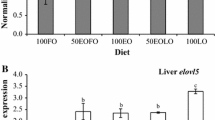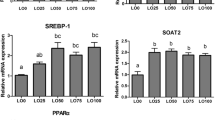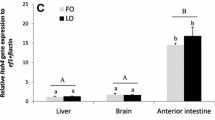Abstract
To evaluate the fatty acid (FA) metabolism status and possibility as a DHA source of farmed Onychostoma macrolepis, a total of 168 fish (2.03 ± 0.23 g) were fed four diets supplemented with fish oil (FO), linseed oil (LO), soybean oil (SO), and a mixture of LO and SO oil (MO), respectively, for 70 days. Body FA compositions were modified reflecting dietary FAs. Comparing liver and intestine fatty acids with fish fed four diets, the content of ARA in fish fed SO was significantly higher than others (P < 0.05), but showed no difference in muscle. The tissue FA profile showed that the FO-fed group successfully deposited DHA, while the LO-fed group converted ALA to DHA effectively, as well as the liver and intestine EPA was notably highest in the FO group, whereas no difference between the FO and LO group in the muscle. The FA results showed that the DHA contents in the muscle of Onychostoma macrolepis are at a medium-high level compared with several other fish species with the highest aquaculture yield. Correspondingly, in the fish fed diet with LO, SO, and MO, the genes of most FA biosynthesis, transportation, and transcriptional regulation factors were increased in the liver and muscle, but no significant difference was observed in the gene expression of Elovl4b, FATP1, and FABP10 in the muscle. In addition, the enzyme activity involved in PUFA metabolism was higher in fish fed vegetable oil-based diets, corroborating the results of the gene expression. Increased in vivo elongase and desaturase (Δ5, Δ6, and Δ9) activities were recorded in fish fed fish oil-devoid diets, which resulted in the appearance of products associated with elongase and desaturase activities in fish. Besides, as the specific n-3 PUFA synthesis substrate, the dietary supplementation of ALA not only retains most of the nutrition value but also ensures the muscular texture, such as fiber diameter and density. It is concluded that farmed O. macrolepis owns strong n-3 LC-PUFA biosynthetic capacity and high DHA contents so it can be a good DHA source for the population.





Similar content being viewed by others
Data availability
No datasets were generated or analysed during the current study.
Abbreviations
- ALA:
-
α-linolenic acid
- ARA:
-
arachidonic acid
- BHT:
-
butylated hydroxytoluene
- CF:
-
condition factor
- DHA:
-
docosahexaenoic acid
- EFA:
-
essential fatty acids
- Elovl :
-
elongation of very long-chain fatty acid proteins
- EPA:
-
eicosapentaenoic acid
- Fads :
-
fatty acyl desaturase
- FAME:
-
fatty acid methyl esters
- FBL:
-
final body length
- FBW:
-
final body weight
- FCR:
-
feed conversion ratio
- FI:
-
feed intake
- FLQ:
-
fish lipid quality/flesh lipid quality
- HH:
-
hypocholesterolemic/ hypercholesterolemic ratio
- HSI:
-
hepatosomatic index
- IA:
-
index of atherogenicity
- IBL:
-
initial body length
- IBW:
-
initial body weight
- IT:
-
index of thrombogenicity
- IPFI:
-
intraperitoneal fat body index
- LA:
-
linoleic acid
- LC-PUFA:
-
long-chain polyunsaturated fatty acid
- MUFA:
-
monounsaturated fatty acid
- PUFA:
-
polyunsaturated fatty acid
- RIL:
-
relative intestine length
- RIW:
-
relative intestine weight
- SFA:
-
saturated fatty acid
- SGR:
-
specific growth rate
- SUR:
-
survival rate
- VSI:
-
viscerosomatic index
- WFAB:
-
whole body fatty acid balance method
- WG:
-
weight gain.
References
AOAC (2003) Official Methods of Analysis of Official Analytical Chemists International, 17th edn. Association of Official Analytical Chemists, Arlington, VA, USA
Betancor MB, Oboh A, Ortega A, Mourente G, Navarro JC, Gándara F, Tocher DR, Monroig Ó (2019) Molecular and functional characterization of a putative elovl4 gene and its expression in response to dietary fatty acid profile in Atlantic bluefin tuna (Thunnus thynnus). Comp Biochem Physiol B 240:110372. https://doi.org/10.1016/j.cbpb.2019.110372
Bian CC, Sun J, Huang XC, Ji SH, Ji H (2022) Endoplasmic reticulum stress is involved in lipid accumulation induced by oleic acid in adipocytes of grass carp (Ctenopharyngodon idella): focusing on the transcriptional level. Fish Physiol Biochem 48(01):275–284. https://doi.org/10.1007/S10695-021-01031-7
Chaiw YT, Giovanni MT, Wing KN (2010) Genetically improved farmed Nile tilapia and red hybrid tilapia showed differences in fatty acid metabolism when fed diets with added fish oil or a vegetable oil blend. Aquaculture 312(01):126–136. https://doi.org/10.1016/j.aquaculture.2010.12.018
Chen JP, Liu HB (2020) Nutritional indices for assessing fatty acids: A mini-review. Int J Mol Sci 21(16):5695. https://doi.org/10.3390/ijms21165695
Chen JY, Yang YY, Huang JH, Mei GM, Zhang XJ, Fang Y (2022) Comparative analysis on nutritional components of Larimichthys crocea from 4 kinds of sources. J Food Saf Food Qual 13(21):7020–7027. https://doi.org/10.19812/j.cnki.jfsq11-5956/ts.2022.21.048
Du XD, Zhang WW, He J, Zhao MJ, Wang JQ, Dong XJ, Fu YY, Xie XD, Miao SY (2022) The impact of rearing salinity on flesh texture, taste, and fatty acid composition in Largemouth Bass Micropterus salmoides. Foods 11(20):3261. https://doi.org/10.3390/FOODS11203261
Folch J, Lees M, Sloane-Stanley GH (1957) A simple method for the isolation and purification of total lipids from animal tissues. J Biol Chem 226(1):497–509
Galindo A, Garrido D, Monroig O, Pérez JA, Betancor MB, Acosta NG, Kabeya-Marrero MA, Bolaños A, Rodriguez C (2021) Polyunsaturated fatty acid metabolism in three fish species with different trophic level. Aquaculture 530:735761. https://doi.org/10.1016/j.aquaculture.2020.735761
Garrido D, Monroig O, Galindo A, Betancor MB, Pérez JA, Kabeya N, Marrero M, Rodríguez C (2020) Lipid metabolism in Tinca tinca and its n-3 LC-PUFA biosynthesis capacity. Aquaculture 523:735147. https://doi.org/10.1016/j.aquaculture.2020.735147
Giovanni MT, David SF, Sena SS (2006) Fatty acid metabolism in the freshwater fish Murray cod (Maccullochella peelii peelii) deduced by the whole-body fatty acid balance method. Comp Biochem Physiol, Part B: Biochem Mol Biol 144(01):110–118. https://doi.org/10.1016/j.cbpb.2006.01.013
Giovanni MT, David SF, Sena SS (2007) A whole body, in vivo, fatty acid balance method to quantify PUFA metabolism (desaturation, elongation and beta-oxidation). Lipids 42(11):1065–1071. https://doi.org/10.1007/s11745-007-3105-x
Giovanni MT, David SF, Sena SS (2008) A Whole Body, In Vivo, Fatty Acid Balance Method to Quantify PUFA Metabolism (Desaturation, Elongation and Beta-oxidation). Lipids 43(10):977. https://doi.org/10.1007/s11745-008-3213-2
Giovanni MT, David SF (2009) Fatty acid metabolism (desaturation, elongation and β-oxidation) in rainbow trout fed fish oil- or linseed oil-based diets. Br J Nutr 102(01):69–81. https://doi.org/10.1017/S0007114508137874
Gou NN, Ji H, Chang ZG, Zhong MZ, Deng W (2020) Effects of dietary essential fatty acid requirements on growth performance, fatty acid composition, biochemical parameters, antioxidant response and lipid related genes expression in juvenile Onychostoma macrolepis. Aquaculture 528:735590. https://doi.org/10.1016/j.aquaculture.2020.735590
Hastings N, Agaba M, Tocher DR, Teale AJ (2001) A vertebrate fatty acid desaturase with Δ5 and Δ6 Activities. Proc Natl Acad Sci USA 98(25):14304–14309. https://doi.org/10.1073/pnas.251516598
Hixson SM, Parrish CC (2014) Substitution of fish oil with camelina oil and inclusion of camelina meal in diets fed to Atlantic cod (Gadus morhua) and their effects on growth, tissue lipid classes, and fatty acids. J Anim Sci 92(03):1055–1067. https://doi.org/10.2527/jas.2013-7146
Imene C, Feriel G, Safa B, Hachana S, Cafsi ME, Azaza MS (2022) Incorporation of ω3 fatty acids in the diets of Nile tilapia juvenile (Oreochromis niloticus L.): effects on growth performance, fatty acid composition, and tolerance to low temperature. Trop Anim Health Prod 54(06):401. https://doi.org/10.1007/S11250-022-03394-2
Jalili M, Hekmatdoost A (2021) Dietary n-3 fatty acids and their influence on inflammation via toll-like receptor pathways. Nutrition 85:111070. https://doi.org/10.1016/j.nut.2020.111070
Jesse T, Artur N (2020) Trophic levels predict the nutritional essentiality of polyunsaturated fatty acids in fish-introduction to a special section and a brief synthesis. N Am J Aquac 82:241–250. https://doi.org/10.1002/naaq.10137
Jing M, Lin D, Wu PP, Kainz MJ, Bishop K, Yan HY, Wang R, Wang Q, Li QH (2020) Effect of aquaculture on mercury and polyunsaturated fatty acids in fishes from reservoirs in Southwest China. Environ Pollut 257(C):113543. https://doi.org/10.1016/j.envpol.2019.113543
Kuah MK, Jaya RA, Shu C (2015) The capacity for long-chain polyunsaturated fatty acid synthesis in a carnivorous vertebrate: functional characterization and nutritional regulation of a Fads2 fatty acyl desaturase with Δ4 activity and an Elovl5 elongase in striped snakehead (Channa striata). BBA Mol Cell Biol L 03:248–260. https://doi.org/10.1016/j.bbalip.2014.12.012
Lien EL, Richard C, Hoffman DR (2018) DHA and ARA addition to infant formula: Current status and future research directions. Prostaglandins, Leukotrienes Essent Fatty Acids 128:26–40. https://doi.org/10.1016/j.plefa.2017.09.005
Li HD, Hu ZC, Liu S, Sun J, Ji H (2022) Influence of dietary soybean meal replacement with yellow mealworm (Tenebrio molitor) on growth performance, antioxidant capacity, skin color, and flesh quality of mirror carp (Cyprinus carpio var. specularis). Aquaculture 561:738636. https://doi.org/10.1016/J.AQUACULTURE.2022.738686
Linhartová Z, Krejsa J, Zajíc T, Másílko J, Sampels S, Mráz J (2018) Proximate and fatty acid composition of 13 important freshwater fish species in central Europe. Aquac Int 26(2):695–711. https://doi.org/10.1007/s10499-018-0243-5
Li YY, Hu CB, Zheng YJ, Xia XA, Xu WJ, Wang SQ, Chen WZ, Sun ZW, Huang JH (2008) The effects of dietary fatty acids on liver fatty acid composition and Δ6-desaturase expression differ with ambient salinities in Siganus canaliculatus. Comp Biochem Physiol, Part B: Biochem Mol Biol 151(02):183–190. https://doi.org/10.1016/j.cbpb.2008.06.013
Li ZW, Zheng SM (2014) Determination and nutrient analysis of amino acids in the muscle of Onychostoma macrolepi. Feed Industry 35(20):65–68
Łuczyńska J, Łuczyński MJ, Nowosad J, Kowalska-Góralska M, Senze M (2022) Total mercury and fatty acids in selected fish species on the polish market: A risk to human health. Int J Environ Res Public Health 19(16):10092. https://doi.org/10.3390/IJERPH191610092
María SR, Teresa G, Carral JM, Celada JD (2022) Fish oil replacement by a blend of vegetable oils in diets for juvenile Tench (Tinca tinca Linnaeus, 1758): effects on growth performance and whole-body composition. Animals 12(09):1113–1113. https://doi.org/10.3390/ANI12091113
Matthew S (2013) Deciphering the role of n-3 polyunsaturated fatty acid-derived lipid mediators in health and disease. Proc Nutr Soc 72(12):441–450. https://doi.org/10.1017/S0029665113003030
Morais S, Torres M, Hontoria F, Monroig Ó, Varó I, Agulleiro MJ, Navarro JC (2020) Molecular and functional characterization of elovl4 genes in Sparus aurata and Solea senegalensis pointing to a critical role in very long-chain (>C24) fatty acid synthesis during early neural development of fish. Int J Mol Sci 21(10):3514. https://doi.org/10.3390/ijms21103514
Nieminen P, Westenius E, Halonen T, Mustonen A (2014) Fatty acid composition in tissues of the farmed Siberian sturgeon (Acipenser baerii). Food Chem 159:80–84. https://doi.org/10.1016/j.foodchem.2014.02.148
Periago MJ, Ayala MD, López-Albors O, Abdel I, Martínez C, García-Alcázar A, Ros G, Gil F (2005) Muscle cellularity and flesh quality of wild and farmed sea bass, Dicentrarchus labrax L. Aquaculture 249(01):175–188. https://doi.org/10.1016/j.aquaculture.2005.02.047
Pornpisanu T, Patcharin R, Sirithon S (2010) Proximate and fatty acids composition of the muscles and viscera of Asian catfish (Pangasius bocourti). Food Chem 122(1):223–237. https://doi.org/10.1016/j.foodchem.2010.02.065
Qin YM, He LY, Wang YF, Li D, Chen WJ, Ye JD (2022) Growth performance, fatty acid composition, and lipid metabolism are altered in groupers (Epinephelus coioides) by dietary fish oil replacement with palm oil. Anim Nutr 8(01):102–113. https://doi.org/10.1016/J.ANINU.2021.04.007
Radovan K, Tomáš B, Jan M, Maršálková E, Maršálek B (2019) The utilization of algae with the aim to increase the fatty acid content in muscle of Common Carp Cyprinus carpio L. Acta Univ Agric Silvic Mendelianae Brun 67(01):91–99. https://doi.org/10.11118/actaun201967010091
Roy BC, Ando M, Itoh T, Tsukamasa Y (2012) Structural and ultrastructural changes of full-cycle cultured Pacific bluefin tuna (Thunnus orientalis) muscle slices during chilled storage. J Sci Food Agric 92(8):1755–1764. https://doi.org/10.1002/jsfa.5542
Salem N, Eggersdorfer M (2015) Is the world supply of omega-3 fatty acids adequate for optimal human nutrition? Curr Opin Clin Nutr Metab Care 18(02):147–154. https://doi.org/10.1097/MCO.0000000000000145
Samuel OM, Mustafa Y, Murat A, Eldem V (2020) Fish oil replacement with different vegetable oils in gilthead seabream, Sparus aurata diets: Effects on fatty acid metabolism based on whole-body fatty acid balance method and genes expression. Aquaculture 529:735609. https://doi.org/10.1016/j.aquaculture.2020.735609
Stefanie MH, Christopher CP, Xue X, Wells JS, Collins SA, Anderson DM, Rise ML (2016) Growth performance, tissue composition, and gene expression responses in Atlantic salmon ( Salmo salar ) fed varying levels of different lipid sources. Aquaculture 467:76–88. https://doi.org/10.1016/j.aquaculture.2016.04.011
Sun J, Li JQ, Li YN, Du JL, Zhao NN, Mai KS, Ai QH (2022) Regulation of Δ6Fads2 gene involved in LC-PUFA biosynthesis subjected to fatty acid in Large Yellow Croaker (Larimichthys crocea) and Rainbow Trout (Oncorhynchus mykiss). Biomolecules 12(05):659. https://doi.org/10.3390/BIOM12050659
Sun J, Xiao PZ, Chang ZG, Ji H, Du ZY, Chen LQ (2017) Forkhead box O1 in grass carp Ctenopharyngodon idella: Molecular characterization, gene structure, tissue distribution and mRNA expression in insulin-inhibited adipocyte lipolysis. Comp. Biochem. Physiol. Part A: Mol Integr Physiol 204:76–84. https://doi.org/10.1016/j.cbpa.2016.11.011
Sun SX, Wang YM, Goh P, Lopes-Marques M, Castro LFC, Monroig Ó, Kuah M, Cao XJ, Shu-Chien AC, Gao J (2021) Evolution and functional characteristics of the novel elovl8 that play pivotal roles in fatty acid biosynthesis. Genes 12(08):1287. https://doi.org/10.3390/GENES12081287
Thanuthong T, Francis DS, Senadheera SPSD, Jones PL, Turchini GM (2011) LC-PUFA biosynthesis in rainbow trout is substrate limited: use of the whole body fatty acid balance method and different 18:3n-3/18:2n-6 ratios. Lipids 46(12):1111–1127. https://doi.org/10.1007/s11745-011-3607-4
Wen L, Tian ML, An YQ, Li WR, Li DP, Liu R, Xiong SB (2022) Effects of different aquaculture mode on nutritional quality and eating quality of grass carp. J Huazhong Agric Univ 41(03):244–251. https://doi.org/10.13300/j.cnki.hnlkxb.2022.03.028
Wing KN, Nicholas R (2013) A review of the nutrition and feeding management of farmed tilapia throughout the culture cycle. Rev Fish Sci 5(04):220–254. https://doi.org/10.1111/raq.12014
Wu QJ, Zheng Z, Wang CJ, Wang Y, Sun YJ, Gao YJ (2022) Molecular characterization, tissue distribution and differential nutritional regulation of three n-3 LC-PUFA biosynthesis-related genes in hybrid Grouper (Epinephelus fuscoguttatus ♀ × Epinephelus lanceolatus ♂). Animals 12(03):234. https://doi.org/10.3390/ANI12030234
Xiao FF, Sun J, Ji H, Yu HB, Dong WZ (2022) Effects of defatted Schizochytrium sp. in diet on the growth, lipid metabolism and health of Onychostoma macrolepis. Shuichan Xuebao 46:1872–1891
Xiao FF, Xing JX, Li HD, Xu XX, Hu ZC, Ji H (2021) Effects of the defatted Schizochytrium sp. on growth performance, fatty acid composition, histomorphology and antioxidant status of juvenile mirror carp (Cyprinus carpio var. specularis). Aquac Res 52(7):3062–3076. https://doi.org/10.1111/ARE.15150
Xie DZ, Chen CY, Dong YW, You CH, Wang SQ, Monroig O, Li YY (2021) Regulation of long-chain polyunsaturated fatty acid biosynthesis in teleost fish. Prog Lipid Res 82:101095. https://doi.org/10.1016/J.PLIPRES.2021.101095
Xie DZ, Guan JF, Huang XP, Xu C, Pan Q, Li YY (2022) Tilapia can be a Beneficial n-3 LC-PUFA Source due to Its High Biosynthetic Capacity in the Liver and Intestine. J Agric Food Chem 70(08):2701–2711. https://doi.org/10.1021/ACS.JAFC.1C05755
Xu HG, Bi QZ, Pribytkova E, Wei YL, Sun B, Jia LL, Liang MQ (2021) Different lipid scenarios in three lean marine teleosts having different lipid storage patterns. Aquaculture 536:736488. https://doi.org/10.1016/J.AQUACULTURE.2021.736448
Xu WJ, Wang SQ, You CH, Zhang YL, Monroig O, Tocher DR, Li YY (2020) The catadromous teleost Anguilla japonica has a complete enzymatic repertoire for the biosynthesis of docosahexaenoic acid from α-linolenic acid: cloning and functional characterization of an Elovl2 elongase. Comp Biochem Physiol B 240:110373. https://doi.org/10.1016/j.cbpb.2019.110373
Xu SG, Wang YZ, Tian ZH, Yang XF, Yang GQ (2011) Nutrient analysis and quality evaluation of muscle in Onychostoma macrolepis. Fish Sci Technol Inform 38(05):258–261
Yang G, Jiang WH, Chen YF, Hu Y, Zhou QB, Peng M, Qu MR, Kumar V (2020) Effect of oil source on growth performance, antioxidant capacity, fatty acid composition and fillet quality of juvenile grass carp (Ctenopharyngodon idella). Aquac Nutr 26(04):1186–1197. https://doi.org/10.1111/anu.13075
Yang LP, Zhang WL, Zhi SY, Zhao MJ, Liu MY, Qin CB, Feng JC, Yan X, Nie GX (2021) Evaluation of dietary genistein on the antioxidant capacity, non-specific immune status, and fatty acid composition of common carp (Cyprinus carpio .L). Aquaculture 550:737822. https://doi.org/10.1016/J.AQUACULTURE.2021.737822
Yue YS, Li QY, Zhang QC, Zhang L, Song JY, Wang H, Liu DZ (1994) Study on the muscle quality of TaiShan Chi-Lin fish. J Shandong Agric Univ (Nat Sci Edition) 25(02):141–146
Zhang WX, Sun SM, Ge XP, Zhu J, Miao LH, Lin Y, Su YL, Liang HL, Pan WJ, Yu H, Huang X, Ji K (2018) Effects of dietary lipid sources on growth performance, fatty acid composition and hepatic lipid metabolism of juvenile blunt snout bream (Megalobrama amblycephala). Aquac Nutr 24(06):1652–1663. https://doi.org/10.1111/anu.12800
Zou WG, Lin ZD, Huang YS, Limbu SM, Wen XB (2019) Molecular cloning and functional characterization of elongase (elovl5) and fatty acyl desaturase (fads2) in sciaenid, Nibea diacanthus (Lacep`ede, 1802). Genes 695:1–11. https://doi.org/10.1016/j.gene.2019.01.033
Funding
All authors would like to thank our colleagues in Prof. Hong Ji’s laboratory for their helpful discussions. Sources of support for the work: This research program was supported by the Shanxi Provincial Postdoctoral Science Foundation (2023BSHEDZZ107).
Author information
Authors and Affiliations
Contributions
Xiangtong Yuan: Methodology, Formal analysis, Investigation, Data curation, Writing – original draft. Ruofan Liu: Formal analysis, Investigation. Mingkui Wei: Data curation. Handong Li: Data curation. Jian Sun: Supervision. Hong Ji: Writing – review & editing, Project administration, Funding acquisition. All authors reviewed the manuscript.
Corresponding author
Ethics declarations
Ethical approval
All experiments were approved by the Northwest A&F University Institutional Animal Care and Use Committee (NWAFU-DKXC- 20200602).
Competing interests
The authors declare no competing interests.
Additional information
Publisher’s note
Springer Nature remains neutral with regard to jurisdictional claims in published maps and institutional affiliations.
Rights and permissions
Springer Nature or its licensor (e.g. a society or other partner) holds exclusive rights to this article under a publishing agreement with the author(s) or other rightsholder(s); author self-archiving of the accepted manuscript version of this article is solely governed by the terms of such publishing agreement and applicable law.
About this article
Cite this article
Yuan, X., Liu, R., Wei, M. et al. Fish oil replacement with different vegetable oils in Onychostoma macrolepis: Effects on fatty acid metabolism based on whole-body fatty acid balance method and genes expression. Fish Physiol Biochem (2024). https://doi.org/10.1007/s10695-024-01357-y
Received:
Accepted:
Published:
DOI: https://doi.org/10.1007/s10695-024-01357-y




